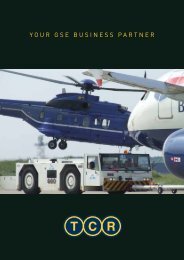WE BRING YOU SAFELY TO TAKE-OFF. - TCR Group
WE BRING YOU SAFELY TO TAKE-OFF. - TCR Group
WE BRING YOU SAFELY TO TAKE-OFF. - TCR Group
Create successful ePaper yourself
Turn your PDF publications into a flip-book with our unique Google optimized e-Paper software.
FEATURE | EQUIPMENT LEASING<br />
Bucking<br />
the trend<br />
Operational leasing of ground support equipment (GSE) aims at reducing the<br />
high financial risk associated with GSE purchase. However, geographical and<br />
operational differences still play a critical role in determining the decision to buy<br />
or rent, reports Keith Mwanalushi<br />
JBT has a GSE pooling programme based on a cost per turn<br />
credit: JBT Aerotech<br />
A<br />
frequent, and fairly straightforward question often posed by<br />
users of GSEs is ‘why own, when you only want to use?’ Owning<br />
GSE ties up capital and, if the wrong purchasing or maintenance<br />
decisions are made, there is an inevitable negative<br />
impact on the bottom line. However, airport operators and ground handlers<br />
will usually frequently turn to a variety of options, from short-term<br />
rentals to longer term operating leases of GSE.<br />
“The last few years have seen an acceleration of the equipment rental<br />
business concept,” outlines Marc Delvaux, CEO at <strong>TCR</strong> <strong>Group</strong>, which provides<br />
turnkey solutions for aviation GSE.<br />
“On the one hand, the airlines and ground handlers are continuously<br />
searching for higher efficiencies and flexibility to counter the fast pace<br />
and higher globalisation of the market.” On the other, Delvaux observes<br />
that in a volatile environment, companies now generally prefer to use<br />
their available financial resources to fund growth strategies rather than<br />
finance capital expenditure and infrastructure like workshops, “especially<br />
when it is now commonly known that these assets are easily made<br />
available through operating lease arrangements. Accordingly, there has<br />
been an increase in demand for rented GSE and for fleet conversion of<br />
existing fleets,” he adds.<br />
In terms of trends and the general market response towards leasing<br />
GSEs, Alan Stearn – executive vice president at Fortbrand Services – says<br />
it’s tough to make a blanket statement regarding the topic. “We see GSE<br />
rentals prevalent in relation to seasonal equipment, such as de-icers and<br />
air conditioners.<br />
“Also, higher priced equipment, such as pushback tractors, de-icers<br />
and air-starts tend to lend themselves to longer term leases, as the<br />
end=user often prefers to spread the cost of the equipment over the term<br />
of its useful life.<br />
“In addition, we’ve found that ground handling providers often like<br />
to match the term of an equipment lease with the term of their handling<br />
contract, thus providing them with the opportunity to return the equipment<br />
if the contract were to not be renewed,” Stearn explains.<br />
The rental model was introduced quite late in the air transportation<br />
industry, about 15 years ago, compared to other asset-intensive industries<br />
like logistics, construction, road transport, rail or information technology,<br />
where equipment rental had long since become a widely used<br />
method of sourcing equipment.<br />
14 AIRSIDE INTERNATIONAL | OC<strong>TO</strong>BER 2012 WWW.AIRSIDEINT.COM



